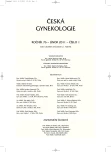Prognosis of the level of perinatal care in the Czech Republic in near future I. Development of perinatal indicators in the Czech Republic
Authors:
Z. Štembera; P. Velebil
Authors‘ workplace:
Ústav pro péči o matku a dítě, Praha-Podolí, přednosta doc. MUDr. J. Feyereisl, CSc.
Published in:
Ceska Gynekol 2011; 76(1): 4-10
Overview
Aim of the study:
Prognosis of the development of perinatal care in the Czech Republic in near future.
Study design:
Nation-wide perinatal epidemiological study.
Setting:
Institute for the Care of Mother and Child, Prague-Podolí.
Methods:
Four basic conditions for prognosis: previous prognosis, current status (previous and actual nationwide perinatal data), current environment, and international data for comparison.
Results:
Prognosis of the Czechoslovak Academy of Science from the beginning of eighties to lower perinatal mortality from 15/1000 to 10/1000 until the year 2000 was accomplished already in 1989. Prognosis of Scientific Board of the Czech Ministry of Health from 2004 analyzed in the first part the causes of improvement of perinatal mortality before and after 1990 and the reasons for increase of newborns under 2000 grams and cesarean sections in 90s. The second part of this prognosis predicted stagnation of perinatal mortality around 4/1000 until the year 2000 and postulated two alternatives for low birth-weight rate from 5.9% to a) 6.9% and b) 8.0% and cesarean section rates increase from 13.5% to a) 17% and b) 22%. This projection was based on previous two prognoses, on the data from the year 2000, and on the analysis of demographic and economic circumstances, and on the comparison of international perinatal data. According to the prognosis, the perinatal mortality decreased to 3.4/1000 in 2009, and the low birth-weight rate and cesarean section rate increased according to the alternative b). Increase of centralization of preterm newborns under 1500 grams and improvement of their birth-weight specific early neonatal mortality (the factors which played the main role in decrease of perinatal mortality before) have already stopped. In the situation of further increase of low birth-weight rate and further deterioration of other negative factors we could expect increase of perinatal mortality above 4/1000.
Conclusion:
According to the two previous prognoses we observed improvements of perinatal care. While the reserves for the continuing improvement (medical and organizational) are already exhausted and while the conditions for provision of care are worsening, we could expect worse perinatal results in terms of further increase of low birth-weight rate, increase of cesarean section rate, and elevation of perinatal mortality above 4/1000.
Key words:
prognosis, perinatal care, international comparison.
Sources
1. Houšťek, J., Macek, M., Štembera, Z., Pfeifer, I. Zdravý tělesný, duševní a sociální vývoj nové generace. Věstník ČSAV, 1982, 91, s. 99-134.
2. Pfeifer, I., Papeš, Z. Vývoj nové generace a některé jeho podmínky. Zdravotnictví v České republice, 2002, 5, s. 157-163.
3. Rodička a novorozenec 2009. Zdravotnická statistika, ÚZIS, 2009.
4. Štembera, Z., Velebil, P. Prognóza péče o reprodukční zdraví v ČR do roku 2010. I. Perinatální péče. Čes Gynek, 2004, 69, Suppl., s. 59-67.
5. Štembera, Z. Historie české perinatologie. Praha: Jessenius – Maxdortf, 2004, 403 s.
6. Štembera, Z., Velebil, P. Mezinárodní srovnání úrovně perinatální péče v ČR. Čes Gynek, 72,2007, 72, s. 5-10.
7. The World Health Report 2005 – Make every mother and child count. WHO Library Cataloguing-in Publication Data. WHO Genf 2005, p. 229.
Labels
Paediatric gynaecology Gynaecology and obstetrics Reproduction medicineArticle was published in
Czech Gynaecology

2011 Issue 1
Most read in this issue
- Use of psychoactive substances and risk sexual behavior
- Fatal course of neonatal citrobacter infection and its legal evaluation
- Female sexual desire disorders – prevalence, classification and treatment possibilities
- Innate immunity in pathogenesis of intraamniotic inflammation in pregnancies complicated by preterm premature rupture of membranes
